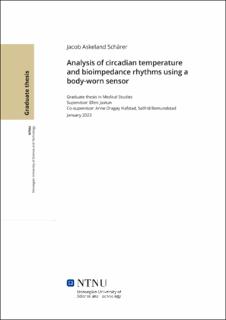| dc.contributor.advisor | Jaatun, Ellen | |
| dc.contributor.advisor | Hafstad, Anne Dragøy | |
| dc.contributor.advisor | Romundstad, Solfrid | |
| dc.contributor.author | Schärer, Jacob Askeland | |
| dc.date.accessioned | 2023-04-22T17:19:59Z | |
| dc.date.available | 2023-04-22T17:19:59Z | |
| dc.date.issued | 2023 | |
| dc.identifier | no.ntnu:inspera:118879259:15887357 | |
| dc.identifier.uri | https://hdl.handle.net/11250/3064346 | |
| dc.description.abstract | Bakgrunn
Mengden elder og skrøpelige personer er økende, det samme gjelder pasienter med kroniske sykdommer som bor hjemme. For mange av disse pasientene vises symptomene ved sykdomsforverring sent i sykdomsforløpet. Forsinket håndtering av symptomer og kroniske lidelser fører til økte plager og er kostbart å reversere. Dagens praksis for å følge opp disse pasientene er både invasive og mindre nøyaktige enn ønsket. På grunn problemene dette byr på, har det blitt utviklet digitale sensorplastre for å følge opp og monitorere pasientener.
Mål
Målet med dette studiet er å studere funksjonen av et nytt sensorplaster som måler bioimpedans på friske frivillige. For å undersøke kvaliteten på sensoren ønsker vi å utforske muligheten til å oppdage fysiologiske
endringer over tid.
Metode
I denne studien ble temperatur- og bioimpedansdata samlet og analysert for 16 friske deltakere. Spredningsplott med «fitline» av kubisk funksjon på gruppenivå ble presentert og det ble utført en tohalet Pearson korrelasjonsanalyse på individnivå. I Pearsonanalysen ble variasjonen fra dag til dag for temperatur og bioimpedans analysert i tillegg til temperatur og bioimpedans fra samme dag.
Resultater
“Fitlines” som presenterte bioimpedans viste en cirkadian rytme for alle tre dager med tydelig nadir og toppunkt. For temperatur ble det kun fremstilt tydelig nadir og toppunkt den første dagen, mens de følgende to dagene avvikte fra den forventede cirkadiane rytmen. Korrelasjonsanalysen var statistisk signifikant.
Konklusjon
Mine funn tilsier at kontinuerlig bioimpedans- og hudetemperaturmåling målt av en kroppsbåren sensor, kan være en nyttig metode for å vurdere folks circadiane rytmer og forstyrrelser i disse, som kan være nyttig for å oppdage sykdom. | |
| dc.description.abstract | Background
The amount of elderly and frail people is increasing, so is also the number of patients with chronic diseases living at home. For many of these patients, the symptoms of deterioration show up late in the disease trajectory. Delayed management of symptoms and chronic diseases pose increased suffering and is costly to reverse. The current state of the art to assess these patients are both invasive and less accurate than desired. Because of these challenges, digital sensor patches have been developed to assess and monitor patients.
The aim
The aim of this study is to study the function of a new bioimpedance sensor patch on a group of healthy volunteers. To define quality of the sensor we want to explore the capacity to detect physiological changes over time.
Method
In this study, temperature and bioimpedance data were collected and analysed from 16 healthy individuals. Scatter plots with cubic function fitlines on group level were presented, and there was performed a 2-tailed Pearson correlation analysis on an individual level. In the pearson correlation analysis the day-to-day variation of temperature and bioimpedance and the correlation between the temperature and bioimpedance from the same day were analysed.
Results
The fitlines presenting the bioimpedance showed circadian rhythms for all three days with a clear nadir and peak. For temperature there was only a clear nadir and peak for the first day, while the following two days deviated from the expected circadian rhythm. The correlation analysis was statistically significant.
Conclusion
My findings suggest that continuous bioimpedance and skin temperature data measured by a body-worn sensor, can be a useful method to assess people’s circadian rhythms and disturbances which can be useful in detecting diseases. | |
| dc.language | eng | |
| dc.publisher | NTNU | |
| dc.title | Analysis of circadian temperature and bioimpedance rhythms using a body-worn sensor. | |
| dc.type | Master thesis | |
